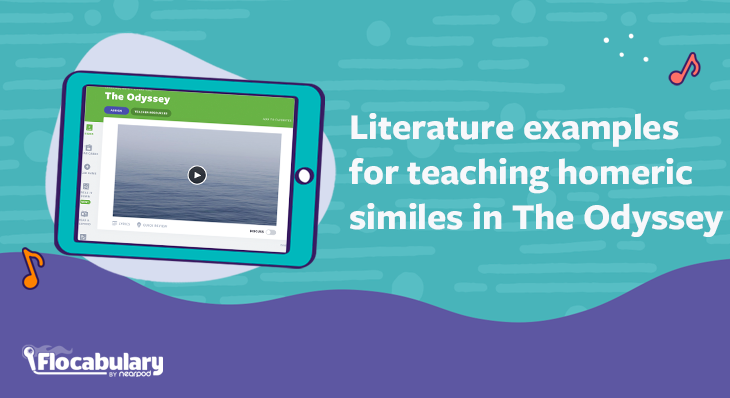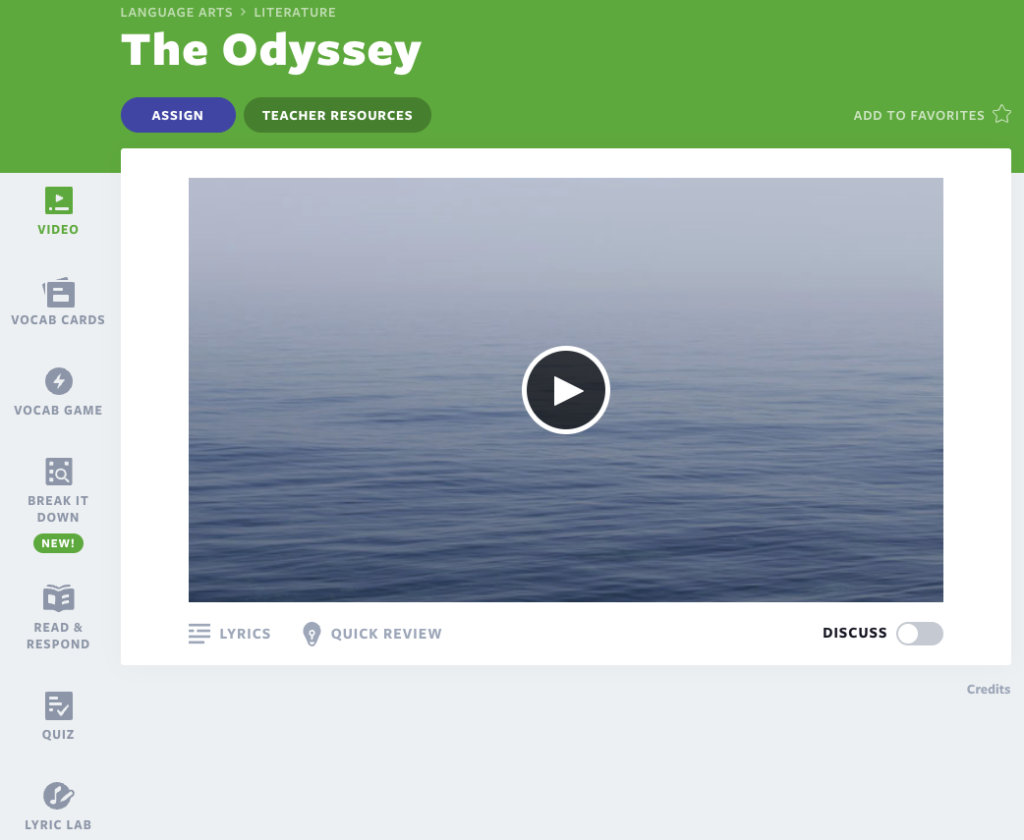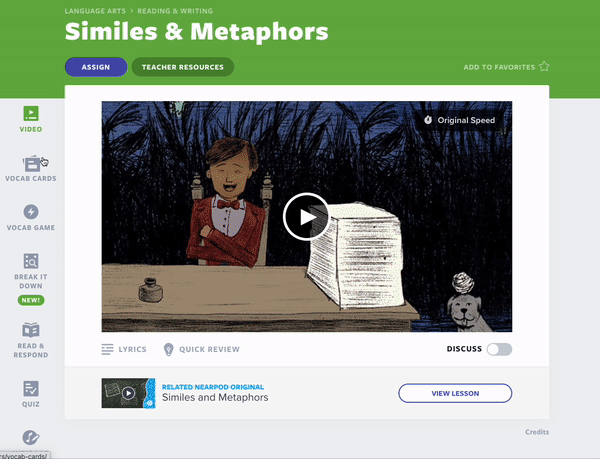
Literature examples for teaching homeric similes in The Odyssey
What is an epic simile?
An epic simile, also known as a “Homeric simile,” is an elaborate and extended comparison in classical literature using like or as, often found in epic poems such as Homer’s “The Odyssey.” This literary device is characterized by its length and complexity, where the likeness between two subjects is explored in great detail. Homer’s epic similes, for instance, can span multiple lines and use vivid imagery to draw parallels between the main narrative and everyday experiences.
We often use short similes to compare in everyday speech, for example, “She’s tough as nails.” In fact, we use them so often that they can become idioms. Homeric similes, however, are used to redirect the reader’s attention in unexpected, humorous, gruesome, or heroic ways. This figurative language technique serves to enhance the storytelling and provide readers with a deeper, more immersive understanding of the text.
Video-based lessons to teach students about epic similes in literature
Flocabulary has K-12 standard-aligned video-based lessons and activities that leverage the power of hip-hop, storytelling, and emotional connections to cultivate literacy across the curriculum. Accelerate student learning through rigorous and authentically engaging instructional experiences with Flocabulary. Sign up below to access the activities and lessons shared in this blog post!
Literature examples for teaching homeric similes in The Odyssey
The Odyssey

This lesson about “The Odyssey” immerses students in the epic’s narrative and its central character, Odysseus, who faces a series of perilous adventures on his journey home. Teachers can use this video lesson as a tool to help students explore the various challenges Odysseus encounters, such as hiding in the Trojan Horse and blinding the Cyclops. By integrating these adventures into a catchy and memorable rap, students can enjoy the epic poem and identify and analyze epic similes in The Odyssey used in the text.
Similes & Metaphors
Start off by teaching students about similes and metaphors before diving into extended metaphors and epic simile examples in literature. Flocabulary offers three different types of video-based lessons to teach students about similes:

- Similes & Metaphors Song: Use this video lesson to introduce students to similes. This lesson leverages vocabulary terms through a hip-hop song to teach students what similes and metaphors are, and how to identify, interpret, and distinguish them. Recommended for Grades 3 to 8.
- *Nearpod Original: Similes and Metaphors: If you’re looking for a short and impactful informational video to teach students about similes and metaphors, check out this video lesson! Recommended for Grades 3 to 5.
- *Simile and Metaphor – Skill and Text Mix: Use this video lesson mix to deepen students’ understanding of similes. A host will explain how authors use similes and metaphors to enhance their writing, and students will practice identifying and analyzing similes and metaphors in a Flocabulary video. Recommended for Grade 4.
*Nearpod Originals and Flocabulary Mix are available to users with a school or district Flocabulary Plus subscription.
Examples of epic similes in the Odyssey
Here are some epic simile examples in literature from one of Homer’s best-known works: The Odyssey.
- Book 1: “As a man and his bride rejoice, when the gods above seal the marriage bond, so longed for, and so dear – she lives with him in happiness, while her parents are happy too – so Odysseus rejoiced, his whole being quickened with longing for his wife.”
- Book 4: “Her mind in torment, wheeling like some lion at bay, dreading the gangs of hunters closing their cunning ring around him for the finish.”
- Book 5: “As a woman weeps, her arms flung about her darling husband, a man who died in the agony and heyday of his youth—she feels him and is crying for him because he would be snatched from life so young, with many tears, for he lay on the threshold of his days—her cheeks burning as she weeps, and she lets fall hot tears, a loving woman weeping for her lord.”
- Book 5: “As a shipwright drills his beam with a shipwright’s drill, that men below, whipping the strap back and forth, whirl and the drill keeps twisting, never stopping – so we seized our stake with it fiery tip and bored it round and round in the giant’s eye.”
- Book 9: “I drove my weight on it from above and bored it home like a shipwright bores his beam with a shipwright’s drill that men below, whipping the strap back and forth, whirl and the drill keeps twisting, never stopping – So we seized our stake with it fiery tip and bored it round and round in the giant’s eye.”
- Book 9: “As a worm shrinks up to nothing, twisting and turning to get away, he shriveled from the sparkling hot rye on the firewood, and twisted his way away like that.”
- Book 9: “Its crackling roots blazed and hissed – as a blacksmith plunges a glowing ax or adze in an ice-cold bath and the metal screeches steam and its temper hardens – that’s the iron’s strength – so the eye of Cyclops sizzled round that stake.”
- Book 13: “Like a lion grown weakly in a cage, and pining for deer, his appetite denied, the taste of blood held back by his keepers, and he hungering for it—his wrath’s consuming in him as he roams up and down his cage—for he yearns to be free and sally into the field. So it was with the tears of Odysseus.”
- Book 19: “As a man in a remote field on a winter’s day turns a plowshare and his plow cuts clean through the soil, following his team across the upturned furrow, and the work is pleasant to him—so then, it seemed the sword cut through the handle of the lance.”
- Book 22: “As two black oxen yoked together with straps and a plough draw down a patch of rich new-turned soil – they bring their strength to bear and break it up; and down from their heads, down go their heads as the plough goes on, while up flies the earth in front of the ploughshare—just so the prince’s neck snapped back into his chest, and he dropped the lid of his shield straight onto the ground, his gory spear thrust out of sight and over his head.”
Start using Flocabulary to teach figurative language
Teaching homeric similes in The Iliad and The Odyssey can help students appreciate the power of vivid images in storytelling. These extended comparisons go beyond common similes, offering rich opportunities for analysis in English Language Arts classrooms. By immersing students in the narrative and the challenges faced by characters like Odysseus, these lessons and examples provide a deeper understanding of the text and its use of figurative language. These epic simile examples in literature and lesson resources can help educators enhance their teaching and make literary analysis more engaging for students.
New to Flocabulary? Teachers can sign up for a trial to access our lesson videos and assessment activities. Administrators can get in touch with us to learn more about unlocking the full power of Flocabulary through Flocabulary Plus.
